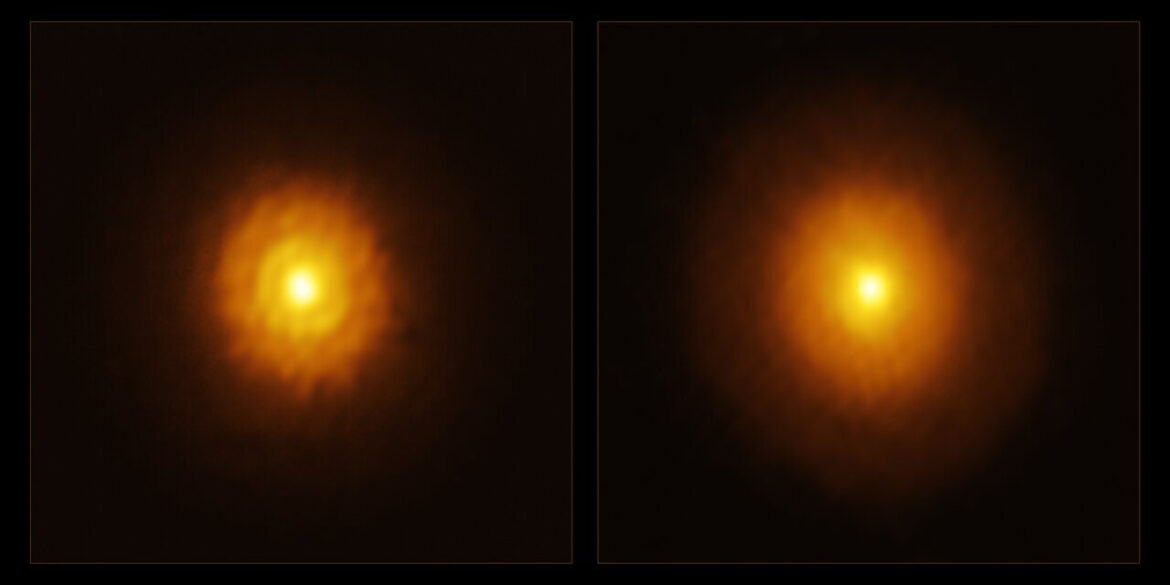A team of astronomers has announced the discovery of a gas giant exoplanet, estimated to be between three and ten times the size of Jupiter, lurking within the dense protoplanetary disk surrounding a young star.
Early observations of the star, known as MP Mus (also referred to as PDS 66), painted a picture of solitude. Scientists initially believed it was surrounded only by a smooth, unremarkable disk of gas and dust, devoid of any planetary companions. The new findings, however, challenge this view, revealing a hidden world shaping its stellar nursery.
The breakthrough came through a combined analysis of data from the Atacama Large Millimeter/submillimeter Array (ALMA) and the European Space Agency’s Gaia mission. The research, spearheaded by an international team from the University of Cambridge and other institutions, marks the first time Gaia has contributed to the indirect detection of an exoplanet within a protoplanetary disk.
Understanding how planets form within these swirling disks is crucial for piecing together the history of our own solar system. According to the prevailing theory of core accretion, particles within the disk collide and gradually coalesce under gravity’s pull, eventually giving rise to asteroids, planets, and other celestial bodies. The birth of a planet often leaves telltale signs, such as gaps carved into the disk, analogous to grooves on a record.
Directly observing these nascent planets, however, is fraught with challenges. The dense gas and dust within the disk obscure the view, making it difficult to distinguish the faint light emitted by a forming planet. To date, only a handful of confirmed detections of young planets within protoplanetary disks have been achieved. The new research offers a potentially powerful new method for indirectly spotting them.
Dr. Álvaro Ribas from Cambridge’s Institute of Astronomy, the lead researcher, said, “We first observed this star at the time when we learned that most disks have rings and gaps, and I was hoping to find features around MP Mus that could hint at the presence of a planet or planets.”
Ribas’s initial ALMA observations of MP Mus, conducted in 2023, revealed what appeared to be a featureless protoplanetary disk. The study showed no gaps or irregularities typically associated with planet formation. “Our earlier observations showed a boring, flat disk,” Ribas explained. “But this seemed odd to us, since the disk is between seven and ten million years old. In a disk of that age, we would expect to see some evidence of planet formation.”
Undeterred, Ribas and his team revisited MP Mus, utilizing ALMA to observe the star at a longer wavelength (3mm). This allowed them to probe deeper into the disk, effectively peering through the obscuring “fog” of gas and dust. The new observations revealed a cavity near the star and two gaps further out, features that were previously hidden from view.
Simultaneously, Miguel Vioque, a researcher at the European Southern Observatory, was analyzing data from the Gaia mission. Gaia is designed to precisely measure the positions and movements of billions of stars, and Vioque noticed something peculiar about MP Mus: it was exhibiting a subtle “wobble.”
Here’s what the combined data revealed:
- Hidden Structures: ALMA’s deeper observations uncovered gaps and a cavity in the protoplanetary disk.
- Stellar Wobble: Gaia data indicated that MP Mus was exhibiting a subtle, periodic movement.
- Modeling Confirms: Computer models suggested that a gas giant within the cavity could explain both the disk structures and the stellar wobble.
“My first reaction was that I must have made a mistake in my calculations, because MP Mus was known to have a featureless disk,” said Vioque. “I was revising my calculations when I saw Álvaro give a talk presenting preliminary results of a newly-discovered inner cavity in the disk, which meant the wobbling I was detecting was real and had a good chance of being caused by a forming planet.” The moment things shifted, from a potentially erroneous blip to a groundbreaking discovery, was palpable, he recalled.
By combining the ALMA and Gaia observations with computer modeling, the researchers concluded that the wobble is likely caused by a gas giant, with a mass less than ten times that of Jupiter, orbiting MP Mus at a distance of one to three times the Earth-Sun distance. This innovative approach to planet hunting opens new avenues for exploring young planetary systems.
“Our modeling work showed that if you put a giant planet inside the new-found cavity, you can also explain the Gaia signal,” said Ribas. “And using the longer ALMA wavelengths allowed us to see structures we couldn’t see before.” This is the first time an exoplanet embedded in a protoplanetary disk has been indirectly discovered in this way , by combining precise star movement data from Gaia with deep observations of the disk. It also means that many more hidden planets might exist in other disks, just waiting to be found.
The discovery underscores the challenges of detecting young planets and highlights the importance of multi-faceted observational strategies. As one astonomer commented on X.com, “Shows how much we can miss if we rely on only one type of data!” Another user on Facebook added, “Amazing work! Imagine how many more are out there!” Instagram posts celebrating the discovery have also emphasized the potential for future finds.
“We think this might be one of the reasons why it’s hard to detect young planets in protoplanetary disks, because in this case, we needed the ALMA and Gaia data together,” said Ribas. “The longer ALMA wavelength is incredibly useful, but to observe at this wavelength requires more time on the telescope.”
Ribas believes that future upgrades to ALMA, as well as next-generation telescopes like the ngVLA, will allow astronomers to probe deeper into protoplanetary disks and uncover even more hidden planets. These discoveries will not only expand our knowledge of planetary formation but also shed light on the origins of our own solar system.
The research, published in the journal Nature Astronomy, provides compelling evidence that our initial impressions of young star systems can be deceiving. What appears to be a simple, featureless disk might, in fact, harbor hidden planets, shaping the environment and dynamics of their surroundings. Further studies of MP Mus and similar systems promise to reveal even more about the complexities of planet formation and the diversity of planetary systems in our galaxy.
More information:
A young gas giant and hidden substructures in a protoplanetary disc, Nature Astronomy (2025). DOI: 10.1038/s41550-025-02576-w



